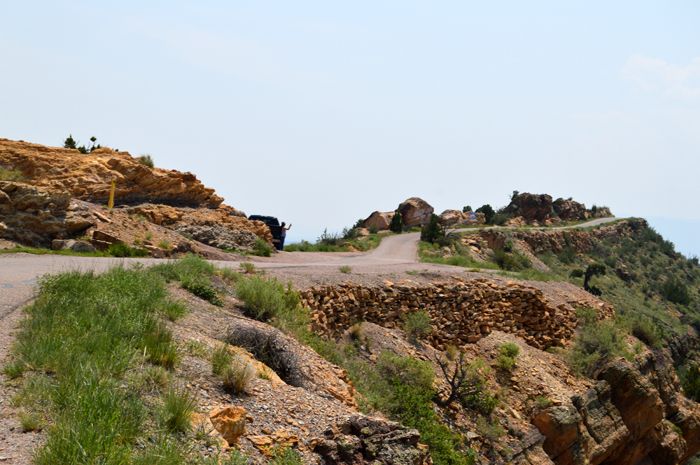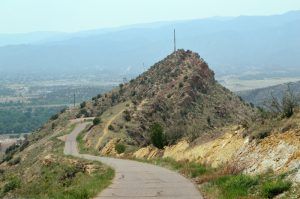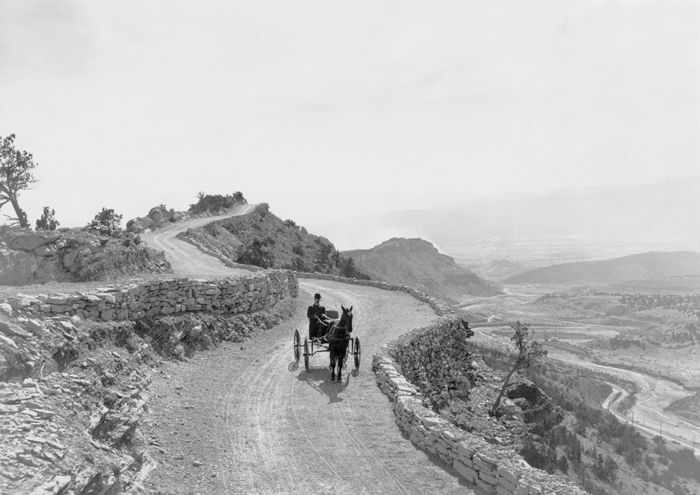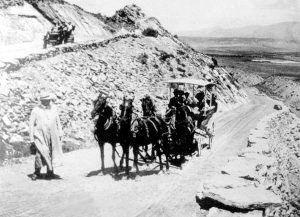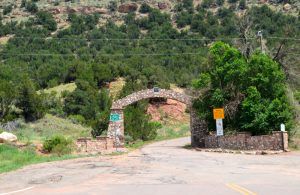Skyline Drive in Canon City, Colorado is a scenic and thrilling 2.6-mile road that provides unparalleled views of the area.
This one-way, narrow road follows the top of a high razorback ridge, with 450-foot drops on both sides in some places. It is not for timid drivers or those afraid of heights. But for those looking for a bit of adventure, its views of Cañon City and the Arkansas River Valley are awesome.
The idea for a road over the Hogback Hills west of Canon City began in 1900 and before long, newspapers began to carry items about the proposed “Alta Vista Drive.”
It was soon decided that the road could be built by inmate labor from the Canon City Territorial Prison and a local committee was formed to raise money. The $2,000 raised was used to pay for the inmates’ tools and supplies to build the road.
“To visit it would prove especially attractive, indeed, we can almost see ourselves speeding along that mountain highway by moonlight.” – Canon City Times
The single-lane road was built in 1905 by 60 inmates working under the direction of Warden John Cleghorn. The inmates got 10 days off their sentence for every 30 days worked.
In the Fall of 1905, a contest was held to name the road and the Cañon City Record called for readers to submit their ideas. Skyline Boulevard was selected; however, from the beginning, it was more often referred to as Skyline Drive.
“Skyline Drive is about the most popular thing that ever happened. Sunday more than 200 vehicles and probably more than 1,000 people viewed the beauties of this rich valley.” – Cañon City Record, February 1906
When the road was opened in 1906, the city council declared it unlawful for automobiles to use the road, reserving it for horse-drawn carriages, bicycles, and foot traffic. Cars were not allowed because they would scare the horses. However, after protests from the community, the council relented in 1907, allowing vehicles on Tuesday mornings and Friday afternoons. The Cañon City Record reported that the council had reservations about their decision because “horse and car conflicts have resulted in the narrow escape of topple over the mountain.” In time, the automobile overtook the horse-and-buggy in popularity and the ordinance was eliminated.
The stunning drive that gave residents and visitors 360-degree views, was soon featured in newspapers and magazines, as far away as New York.
In 1910, a local businessman named Bill Garton had launched the Tally Ho Tour Company which made trips over Skyline Drive in horse-drawn buggies. Using 14 teams of horses, the tour company picked up tourists at the major hotels and train depots, charging 25 cents per person for a ride along the scenic highway. Allen Bowen, another entrepreneur, once ran a snack shop in a small stone pavilion at the top of Skyline Drive.
In 1932, the stone arch at the entrance to Skyline Drive was built, once again utilizing inmate labor. The arch was built using a native stone from each of the 48 states in the union (Alaska and Hawaii did not gain statehood until 1959.)
The most ambitious undertaking was the city’s construction of a 1,4000 seat amphitheater on the east side of the ridge in 1934. Prison inmates, using picks and shovels, dug out a 200-foot area that was named Skyline Bowl. The amphitheater was dedicated on June 12, 1934, with an opera performance with over 700 people in attendance. Sadly, the amphitheater was washed away in a violent storm just a few years later and wasn’t rebuilt.
In 1999, dinosaur footprints were discovered along the ridgeline by a paleontology student. Though visible for years, they weren’t visible to the untrained eye. The site is marked with interpretive signs.
The asphalt road is very narrow, includes some steep sections, and there are no protections or guard rails along some parts of the route. There is no turning around if you change your mind.
The drive makes its way to the top of the ridge, as the landscape falls away hundreds of feet on both sides. There are several pullouts to enjoy the view. Towards the top, there are interpretive signs regarding the dinosaur tracks embedded in the cliff face. The path makes its way along the ridge before descending down the other side via two switchbacks to a residential area. The residential street soon intersects with 5th Street, where signs point south toward U.S. 50 and “Historic Downtown Cañon City.”
The entrance to Skyline Drive is on the west edge of Canon City off U.S. Highway 50.
© Kathy Alexander/Legends of America, updated February 2022.
“Are you sure our Ford F-150 is going to fit on this road? And no, I don’t want to look, just take pictures while I concentrate on not falling off the side.” – Dave Alexander, Legends of America, 2018.

Skyline Drive, Canon City, Colorado by W. Babberger, the early 1920s, courtesy Denver Public Library
Also See:
Sources:

